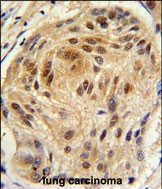

| WB | 咨询技术 | Human,Mouse,Rat |
| IF | 咨询技术 | Human,Mouse,Rat |
| IHC | 1/100-1/500 | Human,Mouse,Rat |
| ICC | 技术咨询 | Human,Mouse,Rat |
| FCM | 咨询技术 | Human,Mouse,Rat |
| Elisa | 咨询技术 | Human,Mouse,Rat |
| Aliases | U6 snRNA-associated Sm-like protein LSm1, Cancer-associated Sm-like, Small nuclear ribonuclear CaSm, LSM1, CASM |
| Entrez GeneID | 27257 |
| WB Predicted band size | 15.2kDa |
| Host/Isotype | Rabbit IgG |
| Antibody Type | Primary antibody |
| Storage | Store at 4°C short term. Aliquot and store at -20°C long term. Avoid freeze/thaw cycles. |
| Species Reactivity | Human |
| Immunogen | This LSM1 antibody is generated from rabbits immunized with a KLH conjugated synthetic peptide between 103-133 amino acids from the C-terminal region of human LSM1. |
| Formulation | Purified antibody in PBS with 0.05% sodium azide,1%BSA and 50% glycerol.prepared by Saturated Ammonium Sulfate (SAS) . |
+ +
以下是3篇关于LSM1抗体的参考文献及其摘要概括:
---
1. **标题**: *LSM1-mediated regulation of mRNA decapping and cell viability in stress conditions*
**作者**: Tharun S, et al.
**摘要**: 本研究揭示了LSM1蛋白在应激条件下通过调控mRNA脱帽复合体维持细胞存活的作用。作者利用LSM1特异性抗体进行免疫沉淀实验,证实其与DCP1/DCP2脱帽酶复合体的相互作用,并发现LSM1缺失导致应激颗粒形成异常,影响细胞应对氧化压力的能力。
---
2. **标题**: *The role of LSM1 in hepatocellular carcinoma progression and its clinical implications*
**作者**: Wang Y, et al.
**摘要**: 通过免疫组化(使用LSM1抗体)分析肝癌组织样本,研究发现LSM1在肿瘤组织中高表达,并与患者预后不良相关。体外实验表明,LSM1通过调控细胞周期相关mRNA的稳定性促进肝癌细胞增殖,提示其作为潜在治疗靶点的可能性。
---
3. **标题**: *LSM1-7 complex dynamics in HIV-1 replication: Insights from antibody-based knockdown studies*
**作者**: Zheng YH, et al.
**摘要**: 本文利用LSM1抗体探究LSM1-7复合体在HIV-1病毒RNA包装中的作用。实验发现,LSM1的敲低导致病毒颗粒中基因组RNA减少,表明该复合体通过稳定病毒mRNA促进病毒复制,为抗病毒治疗提供了新方向。
---
4. **标题**: *Characterization of Arabidopsis LSM1 antibody reveals conserved mRNA decay mechanisms in plants*
**作者**: Perea-Resa C, et al.
**摘要**: 研究通过植物特异性LSM1抗体的开发,证明拟南芥LSM1在mRNA降解途径中保守的功能。免疫荧光实验显示LSM1定位于细胞质加工小体(P-bodies),参与干旱胁迫下特定mRNA的清除,揭示了植物与环境适应的分子机制。
---
以上文献涵盖了LSM1抗体在基础机制、疾病模型及跨物种研究中的应用,可根据研究方向进一步查阅具体实验方法。
The LSM1 antibody is a tool used to study the LSM1 protein, a member of the Like Sm (LSM) family involved in RNA metabolism. LSM1. part of the cytoplasmic LSM1-7 complex, plays a critical role in mRNA degradation by promoting decapping and 5’-to-3’ exonucleolytic decay. It interacts with components of processing bodies (P-bodies) and stress granules, cytoplasmic foci where mRNA turnover and storage occur. LSM1 is essential for regulating gene expression under stress conditions, linking it to cellular stress responses and post-transcriptional regulation.
LSM1 antibodies are widely used in research to detect protein expression, localization, and interactions via techniques like Western blotting, immunofluorescence, and immunoprecipitation. Studies focus on its role in RNA stability, viral replication (e.g., hepatitis C virus), and diseases like cancer or neurodegeneration. Dysregulation of LSM1 has been associated with tumor progression, as it influences oncogene or tumor suppressor mRNA stability. Additionally, LSM1's interaction with AU-rich element (ARE)-binding proteins highlights its importance in inflammation and immune responses.
These antibodies help elucidate mechanisms of RNA metabolism, stress adaptation, and disease pathways, making them valuable in molecular biology and translational research. Commercial LSM1 antibodies are typically validated for specificity in human, mouse, or rat models, supporting diverse experimental applications.
×